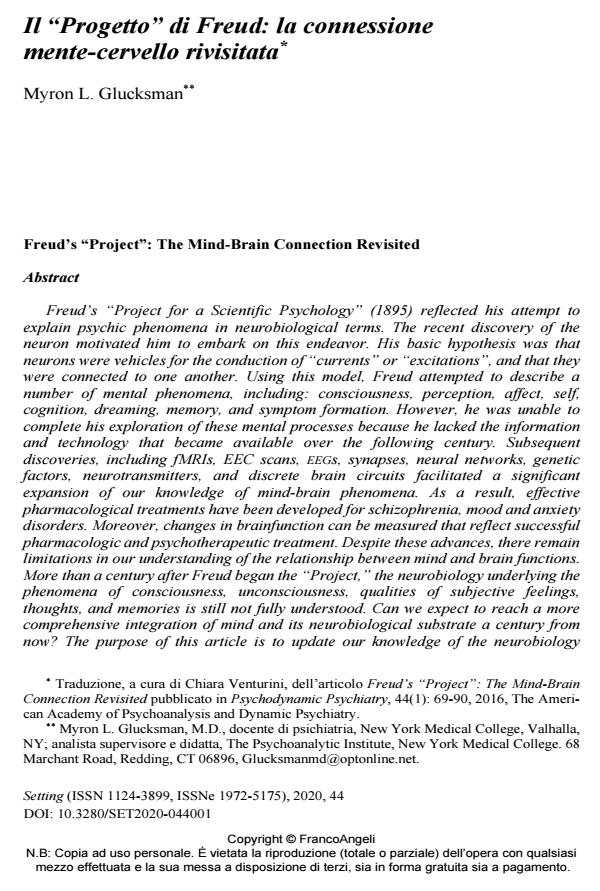Il "Progetto" di Freud: la connessione mente-cervello rivisitata
Titolo Rivista SETTING
Autori/Curatori Myron L. Glucksman
Anno di pubblicazione 2021 Fascicolo 2020/44
Lingua Italiano Numero pagine 26 P. 5-30 Dimensione file 342 KB
DOI 10.3280/SET2020-044001
Il DOI è il codice a barre della proprietà intellettuale: per saperne di più
clicca qui
Qui sotto puoi vedere in anteprima la prima pagina di questo articolo.
Se questo articolo ti interessa, lo puoi acquistare (e scaricare in formato pdf) seguendo le facili indicazioni per acquistare il download credit. Acquista Download Credits per scaricare questo Articolo in formato PDF

FrancoAngeli è membro della Publishers International Linking Association, Inc (PILA)associazione indipendente e non profit per facilitare (attraverso i servizi tecnologici implementati da CrossRef.org) l’accesso degli studiosi ai contenuti digitali nelle pubblicazioni professionali e scientifiche
Il testo di Freud Progetto per una psicologia scientifica (1895) riflette il suo ten-tativo di spiegare i fenomeni psichici in termini neurobiologici, motivato dalla scoperta del neurone avvenuta da poco. La sua ipotesi fondamentale era che i neuroni fossero veicoli per la conduzione di "correnti" o "eccitazioni" e che fossero connessi tra loro. Utilizzando questo modello, Freud ha tentato di descrivere una serie di fenomeni mentali, tra cui coscienza, percezione, affetti, Sé, processi cognitivi, sogno, memoria e formazione del sintomo. Tuttavia, non fu in grado di completare l’esplorazione di tali processi mentali in quanto, all’epoca, mancavano le informazioni e la tecnologia necessarie che sarebbero diventate disponibili nel secolo successivo. Infatti, tecniche quali la risonanza magnetica funzionale (fMRI), la tomografia ad emissione di positroni (PET), l’elettroencefalogramma (EEG), nonché scoperte quali le sinapsi, le reti neurali, i fattori genetici, i neurotrasmettitori e i circuiti discreti del cervello avrebbero facilitato una significativa espansione delle conoscenze sui fenomeni mente-cervello. Tutto questo materiale scientifico ha portato allo sviluppo di efficaci trattamenti farmacologici per la schizofrenia, i disturbi dell’umore e l’ansia. Non solo, ora posso-no essere misurate le variazioni della funzionalità del cervello che riflettono il buon esito dei trattamenti farmacologici e psicoterapeutici. Nonostante questi progressi, la comprensione del rapporto tra le funzioni di mente e cervello rimane limitata. Oltre un secolo dopo la pubblicazione del Progetto non è ancora completamente compresa la neurobiologia sottostante i fenomeni della coscienza, dell’inconscio, delle sensazioni, dei pensieri e della memoria. Possiamo aspettarci di arrivare ad un’integrazione più completa della mente e del suo substrato neurobiologico tra un secolo? Lo scopo di questo articolo è quello di aggiornare la nostra conoscenza della neurobiologia associata alle specifiche funzioni mentali che Freud esaminò nel Progetto, nonché di porre domande riguardanti i fenomeni mente-cervello che si spera troveranno risposte in futuro.
Parole chiave:Coscienza, memoria, isteria, conversioni, processi cognitivi, affetti, mentalizzazione, neuroni specchio
Myron L. Glucksman, Il "Progetto" di Freud: la connessione mente-cervello rivisitata in "SETTING" 44/2020, pp 5-30, DOI: 10.3280/SET2020-044001